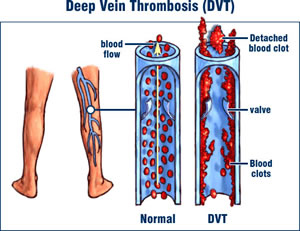Extended air travel and sitting in the narrow seat of a plane has been blamed for the risk of deep vein thromboses (DVT). The formation of a blood clot in the leg veins is not only an inconvenience that causes severe leg swelling. It cannot be ignored, as untreated it may progress to an embolus, a clot that travels in the blood stream to lung or brain. Pulmonary embolism can kill! The affected patient needs treatment with blood thinners to dissolve the clot.
Pamphlets in planes encourage the traveler to move legs, feet and toes to counteract a stagnant blood flow in the leg veins. It remains a good practice for any traveler to get up and move about on lengthy flights. Some individuals are more susceptible than others to develop blood clots. It has been known for a while that the use of oral contraceptives is associated with a risk of clotting.
Dutch researchers under the leadership of Dr. Frits Rosendaal of Leiden Medical Center in the Netherlands recently published some of their findings.
They examined, whether sitting for extended periods in narrow spaces would be the main risk for the formation of DVT. The volunteers were 15 individuals with no known risk factors for DVT. The group also had 11 women, who were carrying the factor V gene (a known risk for blood clotting), 15 women who were taking oral contraceptives, and another group of 15 women who had the factor V Leiden and were taking oral contraceptives. The entire group was taken on an 8-hour flight aboard a chartered 757 jet. Blood samples were taken before, during and after the flight. Several weeks later the same people sat through a movie marathon at a cinema, where the seats had the same legroom as the plane. Blood work was done as with the previous setting on the plane. No one was allowed to drink alcohol, take aspirin or wear compression stockings during the experiments. The test persons were asked to remain seated as much as possible, both during the flight and at the movies.
Finally the group was monitored for 8 hours while they went about their normal day-to-day routines.
The results showed that 17% of the entire group had early signs of possible clotting in their blood after the flight. After the movie marathon only 3% showed the same signs. The rates dropped to 1% during normal everyday routines. As predictable, the group with the factor V gene who were also taking oral contraceptives was at the highest risk.
As a result of these findings, the researchers believe, that sitting is not the only risk for the development of blood clots. The combination of low cabin pressure and low oxygen levels in jet travel may increase the risk for DVT in susceptible individuals.
More on blood clots: http://nethealthbook.com/lung-disease/pulmonary-emboli/
Reference: The Medical Post, March 28,2006, page 50
Last edited Oct. 31, 2014






